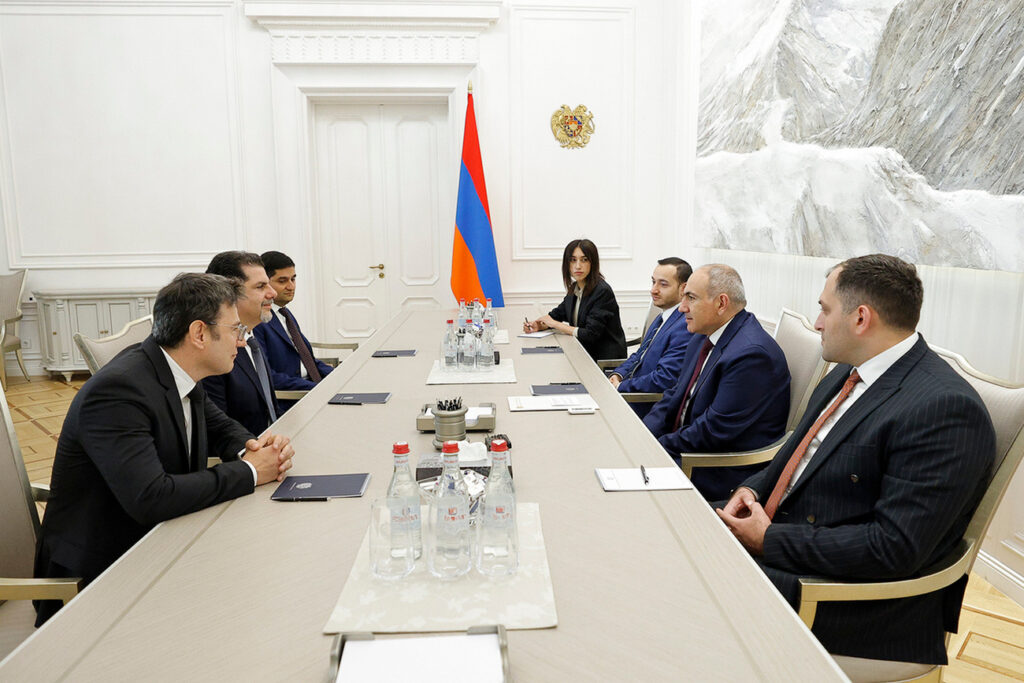With access to Eurasian, Iranian and European markets, strong state incentives and a one-stop support model, Armenia positions itself as a stable and profitable hub for regional growth

ECONOMIC INTERVIEW
Gohar Abajyan
CEO of Enterprise Armenia
For this economic special of Diplomacy & Commerce magazine, we spoke with Gohar Abajyan, Chief Executive Officer of Enterprise Armenia — the national investment promotion agency of the Republic of Armenia. Acting as a true “one-stop shop” for investors, Enterprise Armenia guides projects from initial concept through permits, incentives, and post-investment support, while actively promoting Armenia’s key sectors and shaping policies to ensure a competitive and predictable business environment.
From Armenia, Serbian companies can reach three major directions at once
Armenia positions itself as a strategic hub with access to major markets. How do you see this advantage benefiting potential investors from Serbia specifically?
When we speak about Armenia as a hub, it’s not just a slogan, it’s a practical reality. From Armenia, Serbian companies can reach three major directions at once.
First, as a member of the Eurasian Economic Union, we offer tariff-free access to a market of 180 million consumers, including Russia, Kazakhstan, Belarus and Kyrgyzstan. This gives Serbian manufacturers or agro-producers who invest here an immediate channel to expand eastward with harmonized rules and lower costs.
Second, our ties with Iran are becoming increasingly significant. With the EAEU–Iran Free Trade Agreement, which entered into force in May 2025, Armenia is the natural gateway for accessing Iran’s 80-million-strong market under preferential terms. Combined with the North–South Corridor connecting the Persian Gulf to Black Sea ports, this creates new trade routes that Serbian companies can leverage.

At the same time, Armenia is closely aligned with Europe. The CEPA agreement and our Common Aviation Area with the EU ensure regulatory compatibility and efficient transport connections. This makes operations smoother for companies that are already familiar with European standards.
Taken together, these directions position Armenia as a true bridge between Europe, Asia, and the Gulf, a crossroads where Serbian investors can base their operations and extend reach across multiple regions.
On top of this, Armenia offers strong incentives: Free Economic Zones with full tax exemptions, competitive costs and a skilled workforce. The double taxation treaty with Serbia provides additional certainty for cross-border business. In short, Armenia offers Serbia a stable, efficient, and profitable platform for regional growth.

Enterprise Armenia acts as a “single window” for investors. Could you share some concrete examples of how this model has streamlined investment projects in recent years?
Enterprise Armenia operates as a true single window for investors, accompanying projects from the earliest idea to full launch and continuing with post-investment support. Whether it is a foreign investor entering Armenia for the first time or a local entrepreneur expanding operations, Enterprise Armenia takes on the entire process: from discussions and negotiations with government and local authorities to drafting roadmaps that clearly outline each step, to facilitating legal acts when required by the Government.
In practice, this means investors do not face a fragmented system. For example, the MyLer Free Economic Zone, a major tourism and sports cluster that required land allocation, environmental permits, and access to Free Economic Zone incentives such as tax breaks and customs exemptions, did not have to navigate four separate ministries; instead, all approvals were sequenced and delivered through one channel.
Or consider high-tech. When a leading semiconductor firm explored Armenia, the investor’s first questions spanned taxation, talent, and infrastructure. Normally this would require engaging with three different ministries. Through the “single window,” the company received an integrated investor brief, legal clarifications, and direct introductions to universities – all through one channel. Even in sensitive projects such as the Firebird AI Factory, Armenia’s large-scale AI data center, where regulatory, security and energy considerations are critical, the single window has acted as a bridge between state agencies and private stakeholders. Instead of piecemeal correspondence, investors are receiving a unified government position and a fast-tracked negotiation process.
Enterprise Armenia operates as a true single window for investors, accompanying projects from the earliest idea to full launch
Armenia offers a wide range of fiscal and financial incentives. Which of these are proving most attractive to international investors and why?
Armenia has deliberately shaped its incentive framework to meet the highest expectations of international investors, ensuring it is competitive, transparent and designed to support long-term value creation.
The most important recent development is the adoption of the Law on State Support for the High-Tech Sector. It offers 60% income tax reimbursement on new jobs, 200% deductibility of R&D wages, a 1% turnover tax for tech firms, accelerated depreciation of R&D assets and tax rebates for training staff. Together, these measures cut labor and R&D costs, incentivize innovation and provide long-term predictability for investors.
Beyond high-tech, Armenia offers Free Economic Zones, exemptions from customs duties on imported equipment, subsidized financing through the Modernization of Economic Capacities Program, co-funded infrastructure under the infrastructure-for-investment scheme and capital investment reimbursements of up to 35% for major projects.

The high-tech sector is highlighted as a priority. How does Armenia nurture its tech talent and ensure continuous growth in this industry?
Armenia’s technology sector thrives because the country cultivates talent from the earliest ages and provides clear pathways from education to high-value employment. Programs such as the TUMO Center for Creative Technologies, the nationwide network of Armath Engineering Labs, and the Generation AI initiative introduce schoolchildren to coding, robotics, design and AI. These extracurricular platforms engage more than 25,000 young Armenians each year, giving them early exposure to technology, sparking creativity, and building practical skills long before they enter university.
This early engagement is reinforced by a strong academic foundation, with leading universities graduating more than 5,000 STEM specialists annually, creating a workforce that is skilled, multilingual and globally competitive. Complementary initiatives like Engineering City and regional technology centers in Gyumri and Vanadzor link classroom learning with industry practice and connect talent directly to the labor market.
To ensure continuous growth, Armenia integrates its talent pipeline with strategic projects and international partnerships such as Plug and Play, AWS, Cisco Network Academy. At the same time, major private investments create high-value opportunities at home. A flagship example is Firebird’s forthcoming regional data factory, which will position Armenia as a hub for data processing, artificial intelligence and high-performance computing. This project will not only anchor world-class infrastructure in Armenia but also absorb the highly skilled graduates of these educational and vocational programs, turning early potential into globally competitive expertise.
Armenia has deliberately shaped its incentive framework to meet the highest expectations of international investors
The “Crossroads of Peace” initiative is an ambitious vision. What assurances does it provide to foreign investors who are considering long-term commitments in Armenia?
The “Crossroads of Peace” initiative is more than a transport vision; it is a framework that provides clarity, security and opportunity for investors looking at Armenia over the long term. Built on the principles of sovereignty, jurisdiction, equality and reciprocity, the project guarantees that every state retains full control over the infrastructure on its own territory. For foreign investors this translates into predictable rules of the game and a transparent regulatory environment for cross-border trade, logistics, and industrial operations.
At the same time, the initiative is designed to strengthen regional connectivity, positioning Armenia as a natural hub linking the Black Sea to the Caspian and Europe to the Middle East and Asia. This enhanced connectivity is not only about smoother transport routes but also about an emerging ecosystem of new opportunities in logistics centers, industrial parks, tourism infrastructure, and renewable energy. In this way Armenia emerges into a true crossroads for goods, services and large-scale investments- a regional hub where international partners can align commercial success with long-term sustainable growth.

Economic diplomacy seems central to Enterprise Armenia’s mission. How do you balance global promotion with providing aftercare and policy advocacy for already established investors?
For us at Enterprise Armenia, attracting new investors and retaining existing ones are not separate tasks but two sides of the same mission. Our work in economic diplomacy is about more than promotion-it is about telling Armenia’s story to the world, highlighting priority sectors, convening international forums, leading business missions and strategic partnerships that place Armenia firmly on the global investment map. This proactive promotion ensures visibility and creates a steady pipeline of new investors.
What matters just as much as attracting investors is how we support them once they are here. Through our One-Stop-Shop model, companies receive guidance from registration and permits to reinvestment and growth, while dedicated aftercare ensures their concerns are heard and resolved.
Investor feedback directly informs government reforms in taxation, customs, labor and digital governance, keeping Armenia’s business climate aligned with international standards. By combining promotion abroad with support and reform at home, Enterprise Armenia builds the confidence that turns first-time investments into long-term commitments.
Tourism and green energy are also among Armenia’s promoted sectors. What unique opportunities do you see for growth and partnerships in these areas?
In tourism, Armenia is diversifying its offerings, from cultural heritage and wine routes to eco-tourism in national parks. A flagship example is the Myler Mountain Resort, a large-scale project just one hour from Yerevan, which is transforming Armenia’s mountain tourism with European-standard ski slopes, lifts, and accommodation. Myler has Free Economic Zone status, creating significant tax incentives, and is open to international brands in hospitality, retail, winter sports, and lifestyle services. Armenia welcomes global brands to bring expertise, quality and recognition to its growing tourism landscape.
I see Serbia and Armenia’s economic partnership evolving into more than bilateral trade – it can become a bridge between our regions
In green energy, Armenia has set ambitious goals through its 2040 Energy Sector Development Strategy and renewable-energy programs. The government aims to raise solar generation to at least 15% (1.8 TWh) by 2030 through around 1,000 MW of capacity, while also planning 500 MW of utility-scale wind by 2040. Landmark projects such as the 200 MW Ayg-1 solar plant demonstrate strong investor confidence. The World Bank is financing transmission upgrades to integrate over 1 GW of renewables by 2032, and the EBRD is supporting large-scale solar projects. Together, these developments create opportunities not only in solar and wind generation, but also in smart grids, battery storage, and green construction.
Together, these efforts show Armenia’s commitment to sustainable growth and create platforms where international partners can align commercial success with long-term impact.
Looking ahead, what role do you expect Serbia–Armenia economic relations to play in the broader context of regional integration and cooperation?
I see Serbia and Armenia’s economic partnership evolving into more than bilateral trade-it can become a bridge between our regions. Armenia stands at the intersection of the Eurasian Economic Union, the EU and the Middle East, while Serbia anchors the Western Balkans and connects directly to the EU. This complementarity gives us a natural platform: Serbian companies can reach EAEU and Iranian markets through Armenia and Armenian firms can access the EU and Balkans through Serbia.
Looking ahead, cooperation is likely to deepen in high-tech, agribusiness, pharmaceuticals, and logistics, with joint ventures in areas like food processing or technology services serving not only our domestic economies but wider regional networks. In this way, our partnership contributes directly to broader regional integration.
All Photos: Enterprise Armenia